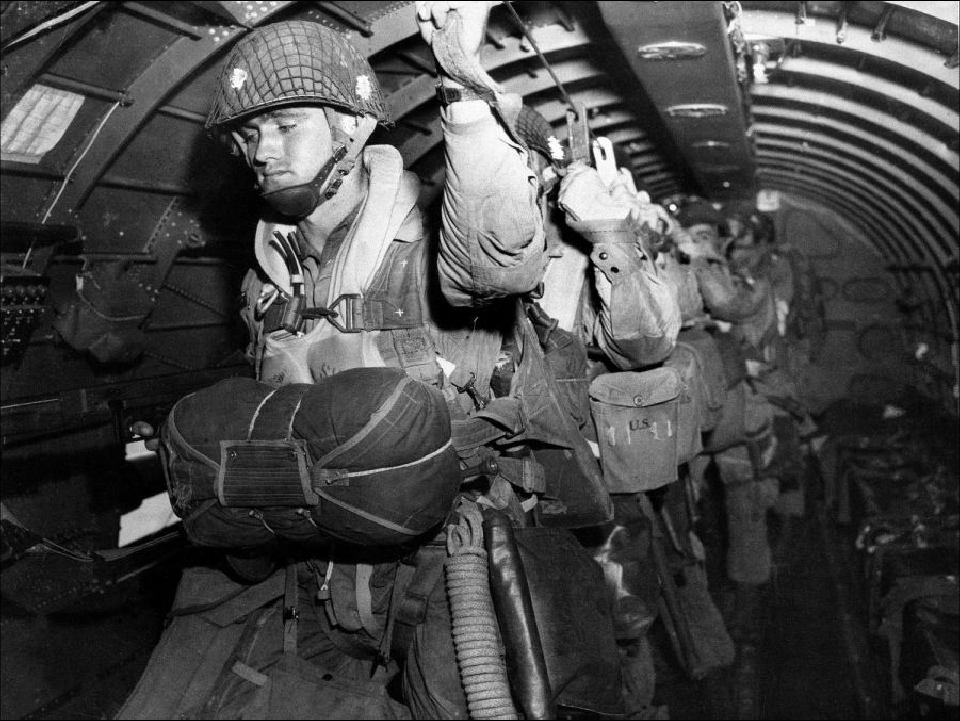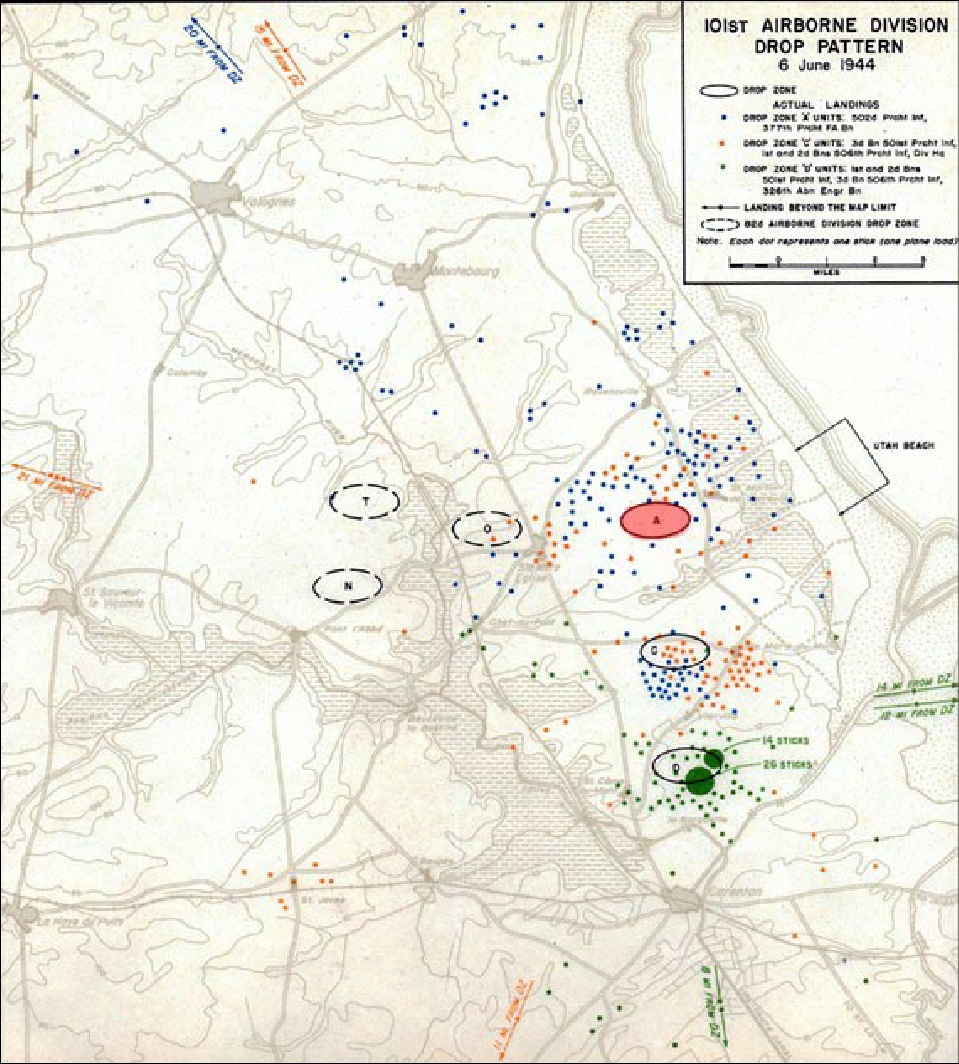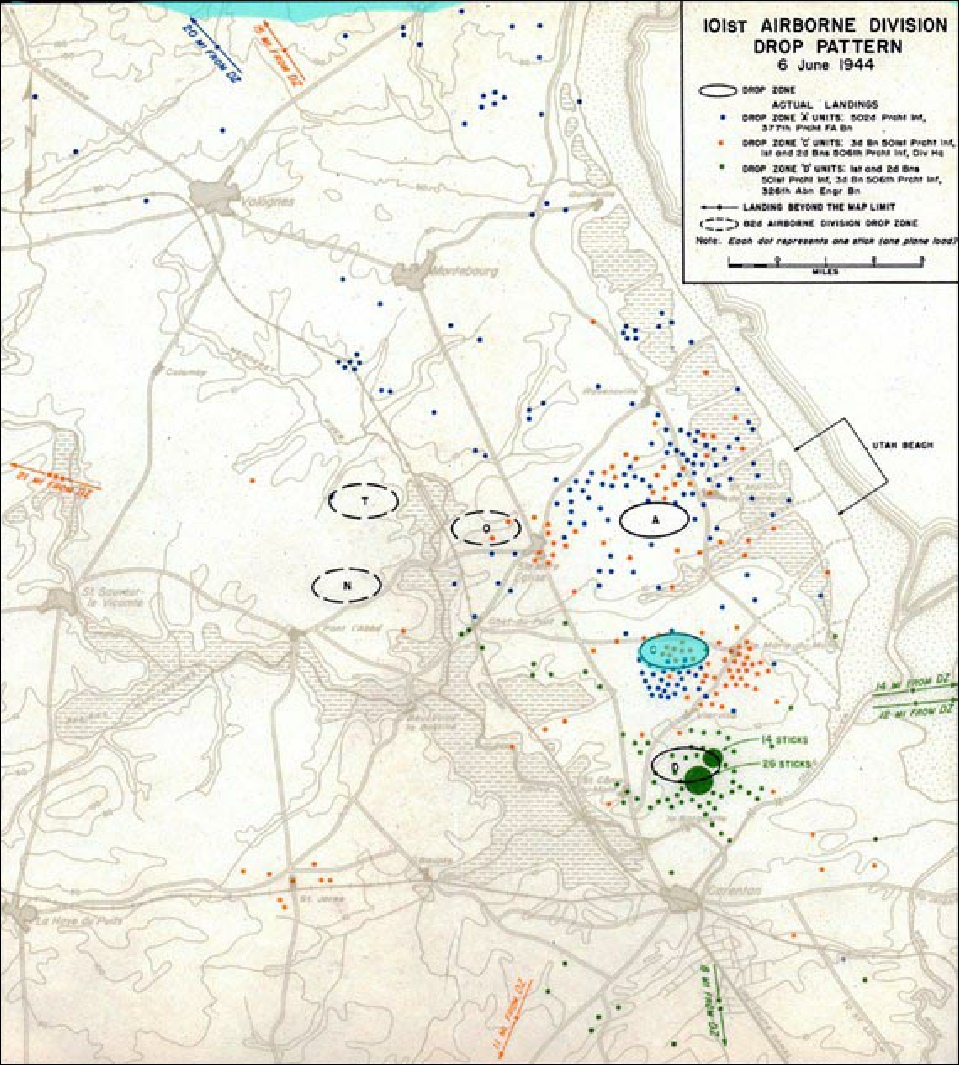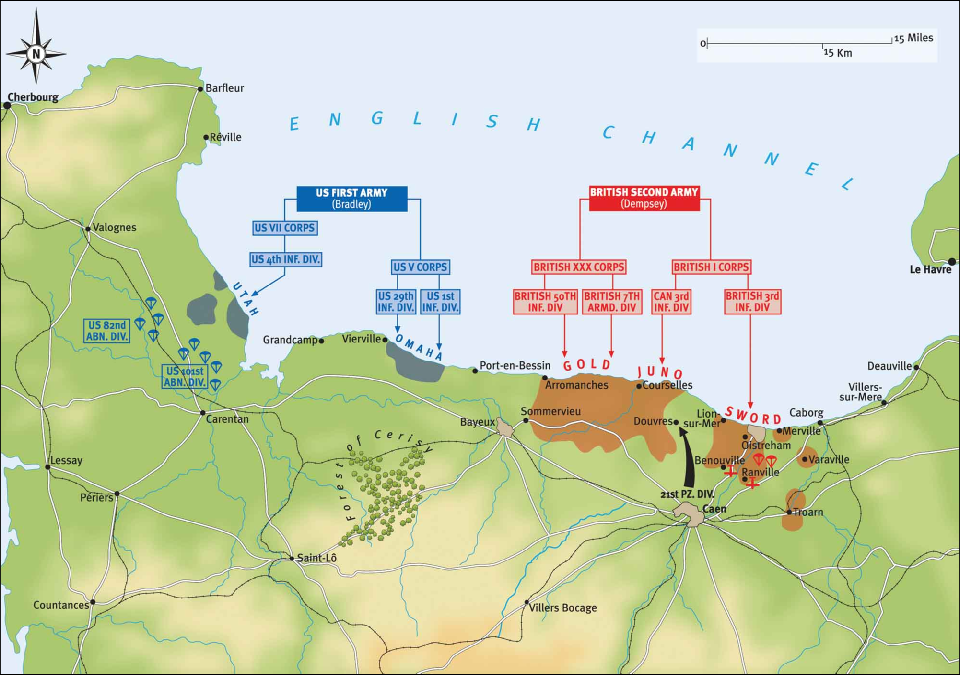South West Airfields Heritage Trust
“Preserving Aviation History for Future Generations”




We have included the details of this mission as it is relevant to the history of Exeter, Merryfield and Upottery Airfields and illustrates the objectives of this mission
Mission Albany was a parachute combat assault at night by the U.S. 101st Airborne Division on June 6, 1944, part of the American airborne landings in Normandy during World War II. It was the opening step of Operation Neptune, the assault portion of the Allied invasion of Normandy, Operation Overlord.
6,928 paratroopers made their jumps from 443 C-
The division took most of its objectives on D-
The 101st Airborne Division's objectives were to secure the four causeway exits behind Utah Beach, destroy a German coastal artillery battery at Saint-
In the process units would also disrupt German communications, establish roadblocks to hamper the movement of German reinforcements, establish a defensive line between the beachhead and Volognes, clear the area of the drop zones to the unit boundary at Les Forges, and link up with the U.S. 82nd Airborne Division.
German forces opposing the operation included the 3rd Battalion, 1058th Grenadier Regiment (91st Air Landing Division) in the vicinity of Saint Come-
Albany was the first of two parachute missions, with "Mission Boston" following it by one hour to drop the 82nd Airborne Division. Each mission consisted of three regiment-
Each of its parachute infantry regiments was transported by three or four "serials" (formations containing 36, 45, or 54 C-
The serials were scheduled over the drop zones at 6-
The main combat jumps were preceded at each drop zone by three teams of pathfinders that arrived thirty minutes before the main assault to set up navigation aids, including Eureka radar transponder beacons and marker lights, to aid the C-
To achieve surprise, the parachute drops were routed to approach Normandy at low altitude from the west. The serials took off beginning at 2230 on June 5, assembled into formations, and flew southwest over the English Channel at 500 feet (150 m) MSL to remain below German radar coverage. Once over water all lights except formation lights were turned off, and these were reduced to their lowest practical intensity. At a stationary marker boat code-
Over the Cotentin Peninsula numerous factors negatively affected the accuracy of the drops, including a solid cloud bank over the entire western half of the 22 miles (35 km) wide peninsula at penetration altitude (1500 feet MSL), an opaque ground fog over many drop zones,and intense German antiaircraft fire ("flak"). The weather conditions broke up and dispersed many formations and the ground fire scattered them even more. However the primary factor limiting success of the paratroop units, because it magnified all the errors resulting from the above factors, was the decision to make a massive parachute drop at night.
D DAY Assault
Drop Zone A
The paratroopers of the 101st Airborne Division "Screaming Eagles" jumped between 00:48 and 01:40 British Double Summer Time on June 6.
The first wave, inbound to Drop Zone A (the northernmost), was not surprised by the cloud bank and maintained formation, but navigating errors and a lack of Eureka signal caused the first error.
Although the 2nd Battalion, 502nd PIR was dropped as a compact unit, it jumped on the wrong drop zone, while its commander, Lieutenant Colonel Steve A. Chappuis, came down virtually alone on the correct drop zone. Chappuis and this stick captured the coastal battery soon after assembling, and found that it had already been dismantled after an air raid.
Most of the remainder of the 502nd PIR (70 of 80 groups) dropped in a disorganized pattern around the impromptu drop zone set up by the pathfinders near the beach. The commanders of the 1st and 3rd Battalions, Lieutenant Colonels Patrick J. Cassidy and Robert G. Cole, took charge of small groups and accomplished all of their D-
Cole's group moved during the night from near Saint Mère Église to the Varreville battery, then continued on and captured Exit 3 at 07:30. They held the position during the morning until relieved by troops moving inland from Utah Beach. Both commanders found Exit 4 covered by German artillery fire and Cassidy recommended to the 4th Infantry Division that it not use the exit.
The division's parachute artillery did not fare nearly as well. Its drop was one of the worst of the operation, losing all but one howitzer and dropping all but two of 54 loads four to twenty miles (32 km) to the north, where most ultimately became casualties.
Drop Zone C – Those dropped by the 439TH from Upottery

The second wave, assigned to drop the 506th PIR on Drop Zone C one mile (1.6 km) west of Sainte Marie-
The 2nd Battalion, much of which had jumped too far west near Sainte Mère Église, eventually assembled near Foucarville at the northern edge of the 101st Airborne Division's objective area. It fought its way to the hamlet of le Chemin near the Houdienville causeway by mid-
Drop Zone D
The third wave also encountered severe flak, losing 6 aircraft. The troop carriers still made an accurate drop, placing 94 of 132 sticks on or close to the drop zone, but part of the DZ was covered by pre-
The surviving battalion commander, Lieutenant Colonel Robert A. Ballard, gathered 250 troopers and advanced toward Saint Côme-
The commander of the 501st PIR, Colonel Howard R. Johnson, collected 150 troops and captured the main objective, the la Barquette lock, by 04:00. After establishing defensive positions, Colonel Johnson went back to the drop zone and assembled another 100 men, including Allen's group, to reinforce the bridgehead. Despite naval gunfire support from the cruiser Quincy, Ballard's battalion was unable to take Saint Côme-
The S-
Other actions
Two other noteworthy actions took place near Sainte Marie-
Around noon, while reconnoitring the area by jeep, Colonel Sink, commanding the 506th PIR, received word that a second battery of four guns had been discovered at Holdy, a manor between his CP and Sainte Marie-
At the end of D-
The 101st Airborne Division had accomplished its most important mission of securing the beach exits, but had a tenuous hold on positions near the Douve River, over which the Germans could still move armored units. The three groups clustered there had tenuous contact with each other but none with the rest of the division. A shortage of radio equipment caused by losses during the drops exacerbated his control problems. Major General Taylor made destroying the Douve bridges the division's top priority and delegated the task to Colonel Sink, who issued orders for the 1st Battalion, 401st GIR to lead three battalions south the next morning.
Saint Côme-
The 101st Airborne Division fought two battles in Normandy after D-
Dead Man's Corner, June 7
The multi-
The far understrength 1st and 2nd Battalions 506th PIR spread out in skirmish line in the dark to move through the hedgerows but were subjected to persistent sniper fire. They covered the twisting dirt road from Culoville to Vierville—a distance of one mile—in four hours. Pushing on beyond the town, they had moved only a thousand yards more by 1100 when a platoon of six Sherman medium tanks of Company A, 746th Tank Battalion appeared.
They moved forward another mile, with Germans constantly infiltrating in behind them, before a sniper killed the commander of the 1st Battalion 506th, Lt Col. William L. Turner. Attacks to clear the flanking hedgerows were thrown back and the advance stalled. Using a newly arrived Stuart light tank as support, Company D advanced at 1830 two miles (3 km) to the battalion objective, the crossroads below Saint Côme-
During the morning, the 1st Battalion of FJR6 cut across country in an attempt to reach their own lines. They were observed by Col. Sink during the morning but not identified as enemy in time to bring them under fire. In the afternoon the German paratroopers crossed the marsh and encountered both Col. Johnson's and Capt. Shettle's pockets. After brief firefights with both at mid-
Round two, June 8
Sink renewed the attack at 0445 with an artillery preparation on the forward German positions. He attacked on a three-
The 506th's battalions were so exhausted that instead of attacking through the hedgerows, they shifted to the left to follow the road from Vierville. Company D, as it had the day before, raced unopposed to Dead Man's Corner and from there up the road toward Saint Côme-
The entangled units reorganized with the companies of the 506th ordered to take up a north-
The 1st/401st GIR, fighting its first action, lagged behind the paratroop units and got into a day-
Battle of Carentan
On June 9 the 101st Airborne Division finished its consolidation. A slow advance off Omaha Beach concerned Allied commanders that German divisions moving towards Carentan might block the merging of the two beachheads, and VII Corps ordered the 101st Airborne Division to take Carentan. Aerial reconnaissance of Carentan indicated that the town might be lightly defended, and a plan to capture the city by a double envelopment was developed.
The attack jumped off shortly after 01:00 of June 10 and made progress encircling the city from the east, where elements of the 327th GIR also linked up with the U.S. 29th Infantry Division. An attack by the 502nd PIR across the causeway was stymied by a bridge obstacle and heavy resistance that was only overcome the next morning by a bayonet charge and hand-
The American units continued their advance to expand their hold around Carentan and establish a solid defensive line. They were counterattacked on June 13 by the 17th SS Panzergrenadier Division and nearly overrun, but were saved by the timely intervention of Combat Command A of the U.S. 2nd Armored Division. The 101st Airborne Division then went into a defensive role for the remainder of its service in Normandy.
Casualties
D-
The August assessment of D-
Casualties totalling 4,500 for the German units involved are approximated by compilation. FJR6 suffered the complete loss of two battalions and the partial loss of a third, and reported 3,000 for the first seven weeks of the battle of Normandy, receiving 1,000 replacements during the campaign. The 91st Infantry Division's III./1058-




Air movement table -
Serial Airborne Unit Troop carrier Group # of C-
1 Pathfinders 1st Pathfinder Prov. 3 RAF North Witham A 0020
2 Pathfinders 1st Pathfinder Prov. 3 RAF North Witham C 0025
6A Pathfinders 1st Pathfinder Prov. 2 RAF North Witham C 0027
3 Pathfinders 1st Pathfinder Prov. 3 RAF North Witham D 0035
7 2d Bn 502d PIR 438th TCG 36 RAF Greenham Common A 0048
8 3rd Bn 502d PIR 438th TCG 45 RAF Greenham Common A 0050
9 1st Bn 502d PIR 436th TCG 36 RAF Membury A 0055
10 377th Para FA 436th TCG 54 RAF Membury A 0108
11 1st Bn 506th PIR 439th TCG 45 RAF Upottery C 0114
12 2nd Bn 506th PIR 439th TCG 36 RAF Upottery C 0120
13 3rd Bn 501st PIR
Div HQ 435th TCG 45 RAF Welford C 0120
14 1st Bn 501st PIR 441st TCG 45 RAF Merryfield D 0126
15 2d Bn 501st PIR 441st TCG 45 RAF Merryfield D 0134
16 3rd Bn 506th PIR
Co C 326th Engr Bn 440th TCG 45 RAF Exeter D 0140
SOURCE: D-
Southwest Airfields Heritage Trust © 2017